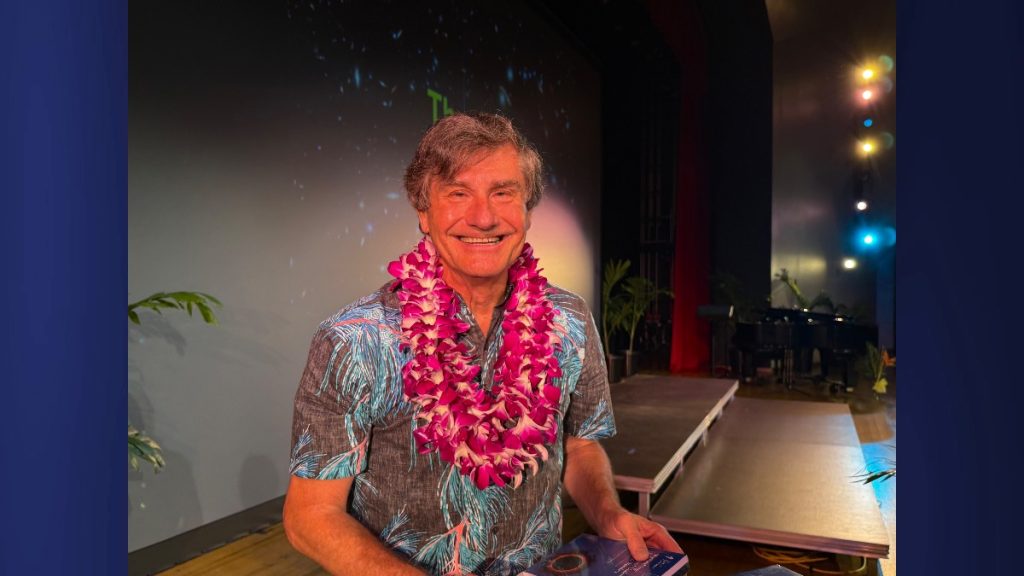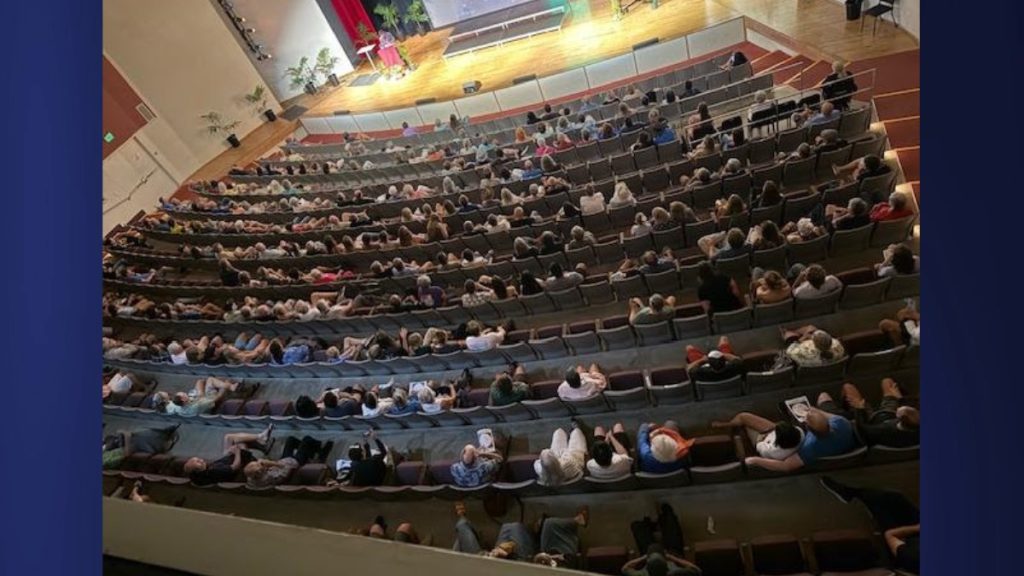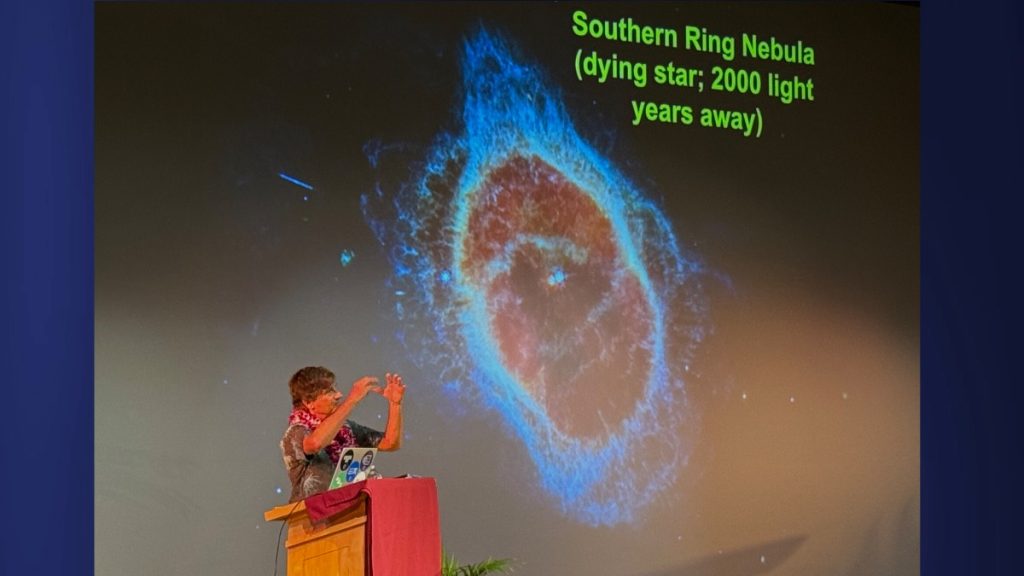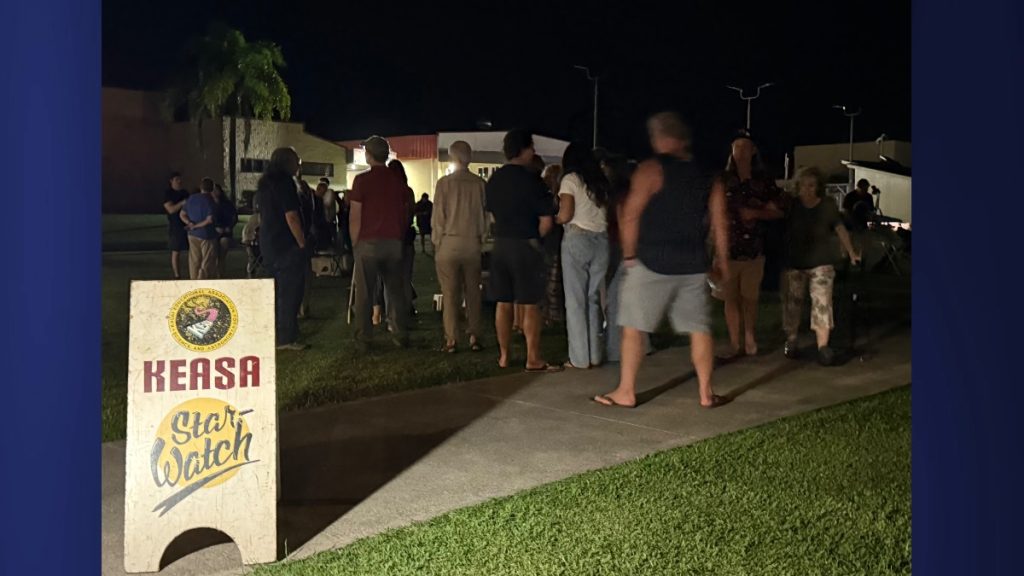World-renowned astrophysicist brings the universe to Kauaʻi

UC Berkeley astrophysicist Dr. Alex Filippenko took a pause from his Kauaʻi vacation to treat about 330 astronomy enthusiasts to a rare glimpse of the universe’s earliest galaxies, recently revealed by the James Webb Space Telescope.
Filippenko said on Saturday that some of the most exciting discoveries are “the early formation and evolution of some galaxies,” which are giant collections of stars gravitationally bound together.
“The James Webb Space Telescope observations have shown that some galaxies already existed just 300 million years after the birth of the Universe (known as the Big Bang), which is sooner than expected.”
Filippenko’s one-night-only lecture at the Kauaʻi Community College Performing Arts Center was sponsored by the Kaua’i Educational Association for Science and Astronomy.

Filippenko shared that while attending a conference in Stockholm, Sweden, he gave a presentation reviewing the history and classification of supernovae (exploding stars).
“There, some of my collaborators talked about our mutual work on supernovae done with the James Webb Space Telescope,” he said.
Filippenko, a leading authority on exploding stars, active galaxies, black holes, gamma-ray bursts and the expansion of the universe, said he and his colleagues are surprised that “there are probably two main reasons early galaxies appear brighter than expected.”
The first explanation is that “some very massive stars formed, and such stars are extremely luminous, so the galaxies are bright not because a lot of Sun-like stars formed, but rather because a much smaller number of very massive and luminous stars formed,” he said.
“Supermassive black holes, hundreds of millions of times the mass of the Sun, seem to have formed very early. Gas falling into the black hole glows very brightly before going inside the black hole, and this makes the galaxy brighter than expected. But such early formation of supermassive black holes presents another mystery.”

Pastor James Merritt, director of the Kaua’i Educational Association for Science and Astronomy, said he was “really shocked” by the turnout “which kind of blew me away.”
“It was such a treat for us to have him here,” he said. “We didnʻt have enough starmaps to cover everyone, and it was such a treat to know that so many people on Kauaʻi love astronomy.”
Filippenko has produced several astronomy video courses with The Great Courses, co-authored an award-winning textbook, and appears in numerous TV documentaries including about 50 episodes of the History Channel’s The Universe series.
Filippenko said astrophysicists are grateful for permission to build and use telescopes on Maui’s Haleakala and the Big Island’s Maunakea, which is “arguably the best site in the world for astronomical observations.”
He hopes that astronomers can continue to conduct research and educational efforts on Maunakea.
“Not only does this increase our understanding of the Universe, but it brings to Hawaiʻi international prestige, excellent jobs, educational outreach and tourism,” he added.
On June 30, 2028, following a five-year transition period, the Maunakea Stewardship and Oversight Authority will assume responsibility from the University of Hawai‘i for the more than 11,000 acres atop the Big Island volcano of Maunakea that is sacred to many Native Hawaiians.
The authority will help guide what can and cannot be done on Maunakea moving forward.
After Filippenko’s talk, the audience was able to observe the planets through six telescopes set up on the Performing Arts’ lawn by the Kauaʻi astronomy association for their monthly star watch party.

Two weeks ago, the association held a star watch party at the Pacific Missile Range Facility. They searched for a dwarf planet beyond Pluto, where a star passing behind it would let astronomers evaluate whether the planet has an atmosphere.
Dr. James Dyer, an astrophysicist and professor at the University of Texas, will be moving back to the Garden Isle next year to optimize the telescope setup at the Pacific Missile Range Facility.
Merritt said the association is excited for Dyerʻs return and hope to be able to do more star watching at the military facility and “we’re hoping to get more of our members being able to use our larger telescopes that are computer-driven.”
The Kaua’i Educational Association for Science and Astronomy was established in 1989 and has gathered amateur astronomers on Kaua’i monthly for star watches at Kaumakani Park & Sports Pavilion, between Hanapēpē and Waimea, throughout the years.
“Deep, deep thankfulness to Dr. Filippenkoʻs willingness, on his vacation, to take time out to come and help strengthen our small astronomy club,” Merritt said.
Filippenko said: “My wife Noelle and I love Kauaʻi, and we knew that I would need somewhat of a break from a grueling semester at UC Berkeley. So we decided to take this vacation during which I’m still doing some work.”
He encourages everyone to become a member of the local association and “study lots of math and physics in order to have the fundamental knowledge needed to become an astrophysicist.
To sign up for the Kaua’i Educational Association for Science and Astronomy newsletter or to become a member and fill out the application, click here.



